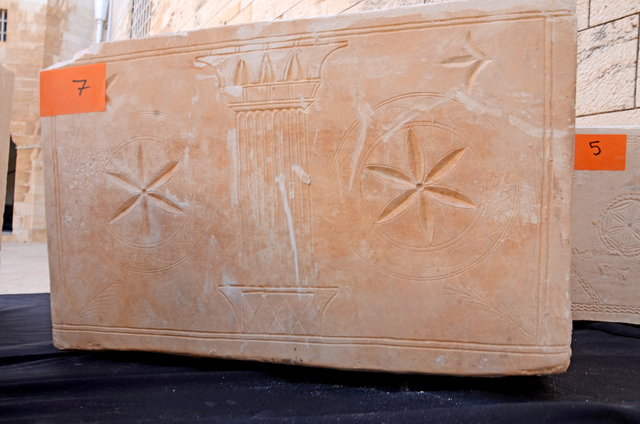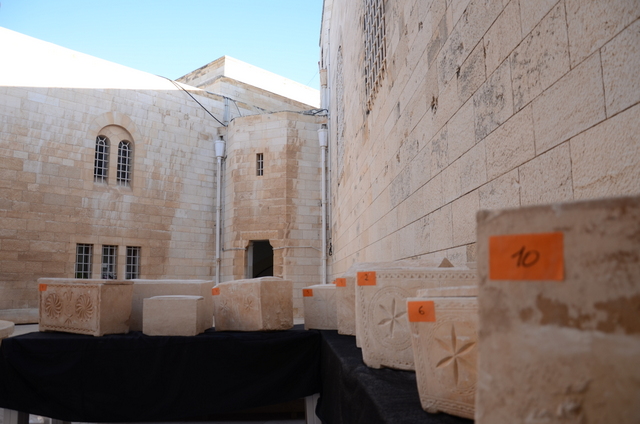A
new translation of a 6-foot-tall calcite block called the Tempest Stela
suggests the Egyptian pharaoh Ahmose ruled at a time 30 to 50 years earlier
than previously thought—a finding that could change scholars’ understanding of
a critical juncture in the Bronze Age.
Courtesy
of Metropolitan Museum of Art
An inscription on a
3,500-year-old stone block from Egypt may be one of the world’s oldest weather
reports—and could provide new evidence about the chronology of events in the
ancient Middle East.
A new translation of a 40-line
inscription on the 6-foot-tall calcite block called the Tempest Stela describes
rain, darkness and “the sky being in storm without cessation, louder than the
cries of the masses.”
Two scholars at the University
of Chicago’s Oriental Institute believe the unusual weather patterns described
on the slab were the result of a massive volcano explosion at Thera—the
present-day island of Santorini in the Mediterranean Sea. Because volcano
eruptions can have a widespread impact on weather, the Thera explosion likely
would have caused significant disruptions in Egypt.
The new translation suggests
the Egyptian pharaoh Ahmose ruled at a time closer to the Thera eruption than
previously thought—a finding that could change scholars’ understanding of a
critical juncture in human history as Bronze Age empires realigned. The
research from the Oriental Institute’s Nadine Moeller and Robert Ritner appears
in the spring issue of the Journal of Near Eastern Studies.
The Tempest Stela dates back to
the reign of the pharaoh Ahmose, the first pharaoh of the 18th Dynasty. His
rule marked the beginning of the New Kingdom, a time when Egypt’s power reached
its height. The block was found in pieces in Thebes, modern Luxor, where Ahmose
ruled.
If the stela does describe the
aftermath of the Thera catastrophe, the correct dating of the stela itself and
Ahmose’s reign, currently thought to be about 1550 B.C., could actually be 30
to 50 years earlier.
“This is important to scholars
of the ancient Near East and eastern Mediterranean, generally because the
chronology that archaeologists use is based on the lists of Egyptian pharaohs,
and this new information could adjust those dates,” said Moeller, assistant
professor of Egyptian archaeology at the Oriental Institute, who specializes in
research on ancient urbanism and chronology.
In 2006, radiocarbon testing of
an olive tree buried under volcanic residue placed the date of the Thera
eruption at 1621-1605 B.C. Until now, the archeological evidence for the date
of the Thera eruption seemed at odds with the radiocarbon dating, explained Oriental
Institute postdoctoral scholar Felix Hoeflmayer, who has studied the
chronological implications related to the eruption. However, if the date of
Ahmose’s reign is earlier than previously believed, the resulting shift in
chronology “might solve the whole problem,” Hoeflmayer said.
The revised dating of Ahmose’s
reign could mean the dates of other events in the ancient Near East fit
together more logically, scholars said. For example, it realigns the dates of
important events such as the fall of the power of the Canaanites and the
collapse of the Babylonian Empire, said David Schloen, associate professor in
the Oriental Institute and Near Eastern Languages & Civilizations on
ancient cultures in the Middle East.
“This new information would
provide a better understanding of the role of the environment in the
development and destruction of empires in the ancient Middle East,” he said.
For example, the new chronology
helps to explain how Ahmose rose to power and supplanted the Canaanite rulers
of Egypt—the Hyksos—according to Schloen. The Thera eruption and resulting
tsunami would have destroyed the Hyksos’ ports and significantly weakened their
sea power.
In addition, the disruption to
trade and agriculture caused by the eruption would have undermined the power of
the Babylonian Empire and could explain why the Babylonians were unable to fend
off an invasion of the Hittites, another ancient culture that flourished in
what is now Turkey.
‘A TEMPEST OF RAIN’
Some researchers consider the
text on the Tempest Stela to be a metaphorical document that described the
impact of the Hyksos invasion. However, Ritner’s translation shows that the
text was more likely a description of weather events consistent with the
disruption caused by the massive Thera explosion.
Ritner said the text reports
that Ahmose witnessed the disaster—the description of events in the stela text
is frightening.
The stela’s text describes the
“sky being in storm” with “a tempest of rain” for a period of days. The
passages also describe bodies floating down the Nile like “skiffs of papyrus.”
Importantly, the text refers to
events affecting both the delta region and the area of Egypt further south
along the Nile. “This was clearly a major storm, and different from the kinds
of heavy rains that Egypt periodically receives,” Ritner said.
In addition to the Tempest
Stela, a text known as the Rhind Mathematical Papyrus from the reign of Ahmose
also makes a special point of mentioning thunder and rain, “which is further
proof that the scholars under Ahmose paid close and particular attention to
matters of weather,” Ritner said.
Marina Baldi, a scientist in
climatology and meteorology at the Institute of Biometeorology of the National
Research Council in Italy, has analyzed the information on the stela along with
her colleagues and compared it to known weather patterns in Egypt.
A dominant weather pattern in
the area is a system called “the Red Sea Trough,” which brings hot, dry air to
the area from East Africa. When disrupted, that system can bring severe
weather, heavy precipitation and flash flooding, similar to what is reported on
the Tempest Stela.
“A modification in the
atmospheric circulation after the eruption could have driven a change in the
precipitation regime of the region. Therefore the episode in the Tempest Stela
could be a consequence of these climatological changes,” Baldi explained.
Other
work is underway to get a clearer idea of accurate dating around the time of
Ahmose, who ruled after the Second Intermediate period when the Hyksos people
seized power in Egypt. That work also has pushed back the dates of his reign
closer to the explosion on Thera, Moeller explained.







